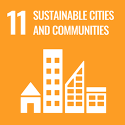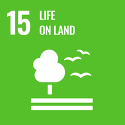Objectives and targets
Key objective: to take actions to avoid the impact of climate change and extreme weather events on campus.
Response lead: Estates and Campus Services
Our principal aim in climate adaptation and biodiversity is to take all necessary steps to mitigate or avoid the impacts of climate change and extreme weather on the University estate and surrounding areas, to safeguard business continuity, and to enhance the University’s unique estate to further biodiversity.
Key objective: to take actions to avoid the impact of climate change and extreme weather events on campus.
Response lead: Estates and Campus Services




/filters:format(webp)/prod01/cdn/media/stirling/global-assets/landscape/banners/campus-May-loch.jpg)
The campus landscape is much loved by our students, staff and visitors, as well as the wider community. Rich in beauty, wildlife and history, the campus is designated as a Historic Garden and Designed Landscape and is also within an Area of Great Landscape Value.
We recognise that climate change and extreme weather conditions pose significant risks to business continuity. This was borne out in 2019 when the University suffered severe and unprecedented floods causing over £10 million of damage to buildings and grounds. The impacts were far-reaching with restoration taking over a year to complete. Since then, significant work has been carried out to improve drainage across the campus, and to find natural solutions to challenges posed by climate change and extreme weather events.
In addition to physical alterations to our campus, we have in place a Severe Weather Response Plan which sets out how the University co-ordinates its response to severe weather events. Also, the Major Incident Response Team (MIRT) has procedures in place to deal with emergencies, including severe weather impacts.
In keeping with our legal duty to adapt our buildings and estate to climate change (Climate Change (Scotland) Act 2009) and to build further resilience into our business practices, the University has put in place a climate change adaptation programme to ensure that it is better placed to avoid or mitigate the effects of severe weather (e.g., by replacing hard paths with gravel or other porous material where appropriate). We are also exploring the use of Sustainable Drainage Systems (SuDS), especially in new build designs to better manage increased surface water.
Risk assessments have been carried out across all faculties and directorates to identify any vulnerabilities to extreme weather events, and these will form the basis of an active climate change risk register, monitored by the Corporate Sustainability Steering Group. In doing so, we have identified building areas that are prone to extreme temperatures and have taken appropriate mitigating actions. We have installed non-return valves in waste networks to avoid the back up of waste into buildings in the event of floods and have improved drainage and air spaces in waterlogged areas to reduce run-off and to prevent tree root death. We have also undertaken significant ground works on the edge of Airthrey Loch to help stabilise banks that have become eroded over time.
It is recognised that urgent action is required to find solutions to rapidly changing ecosystems and the loss of biodiversity across the world. The University actively manages its 334-acre estate in terms of biodiversity and boasts a rich and diverse range of plant and animal life, including several threatened or endangered species (e.g., pine martens and red squirrels). We have increased the provision of dead wood to provide habitats for fungi and invertebrates and increased the provision of nesting boxes for bird and bat species. In doing so, we have enhanced staff, student, and community awareness of the biodiversity of the campus and promoted these habitats as educational and recreational resources. Biodiversity is also a key priority in the development of all new University building projects.
In terms of the maintenance of the campus, we continue to adapt maintenance regimes that are sympathetic to biodiversity. We have adopted the use of natural plant-based products to treat weeds (e.g., the use of Pelargonium extract) and have returned much of the 12-acre golf course to natural parkland meadow. We have created ecotones (transition areas that are species-rich) to increase nectar-bearing flowers and seed-heads through the reduction in grass cutting. We have also increased the planting of native tree and shrub species to add to and diversify food sources for invertebrates and birds, and edible fruiting species for human consumption. We are currently updating our Biodiversity Plan and will publish it on the website when available.
A large proportion of our estate is woodland and comprises approximately 5,000 mature trees. We are taking steps to systematically improve the age and canopy structure of our woodlands through the planting of long-lived tree species. We have also improved the green network routes for small mammals through habitat linkage between wetlands and hedge or woodland edges. In taking forward all these actions, we are gradually restoring much of the University campus to the original 18th century Airthrey Estate.
Progress in terms of biodiversity is monitored and reported to the Corporate Sustainability Steering Group, and via our reports to Scottish Government.